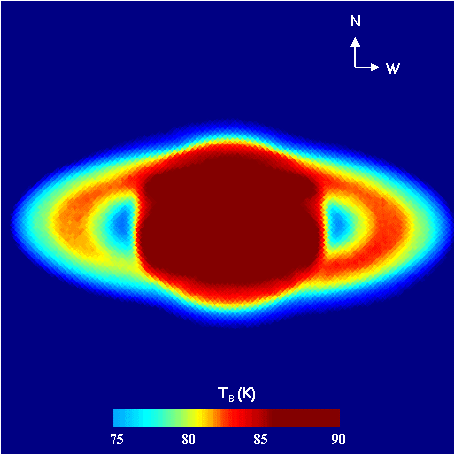CFHT, Current Image of the Week
CFHT's ASTRONOMY PICTURE OF THE WEEK
December 13th, 1999
Thermal Inertia of Saturn's Ring Particles
Each week, discover a new spectacular image obtained
at CFHT.
Browse the archive

Thermal Inertia of Saturn's Ring Particles
Credit:
Image courtesy of C. Ferrari, P. Galdemard, P.O. Lagage, & E. Pantin
Equipe GammaG, Université Paris 7, France
Service D'Astrophysique, DAPNIA/DASM/CEA Saclay, France
(Presented at the 31st Annual Meeting of the Division of Planetary Science
of the American Astronomical Society
Planet Saturn is seen here in the mid-infrared, at 20.5 microns. The
image was obtained with CAMIRAS attached to the CFHT. As opposed to
images taken in the optical where the rings reflect the sunlight,
Saturn's rings are visible here because of the thermal emission of
the dust particles they contain.
This CAMIRAS image allows to estimate the grain properties
in Saturn's rings. Clearly, the rings on one side of Saturn are
warmer (red), while the particles on the opposite side are cooler (yellow).
Notice the color-coded temperature scale at the bottom of the image.
The sun is shining on Saturn almost from behind you (the reader) on the
image, and the particles are orbiting the planet clockwise. The particles
warm up on the sunny side and cool down in the eclipse zone.
The eclipse zone is behind Saturn on this image, it is at the bottom and
not visible directly. The particles come out of the eclipse zone from
the bottom left where they appear the coolest. They rapidly warm up along
their orbit as they receive energy from the Sun. They finally enter the
eclipse zone again (at bottom right this time) where they cool down again
to start a new cycle.
The thermal inertia and the mean particle size in Saturn's
ring A, B & C can be estimated from the cooling and heating rates measured
by CAMIRAS at CFHT. The observed temperature gradient between both sides
is 3 degrees Kelvin, suggesting a low thermal inertia. The same effect
(and gradients) is seen in all three rings (A, B, and C). The rings are not
distinguishable on this image but their positions are indicated on this
one. The images of Saturn obtained by the CAMIRAS
group will help prepare the
CASSINI space mission.
Technical description:
This images was obtained on July 29th, 1999, with CAMIRAS attached the
to Canada-France-Hawaii telescope. CAMIRAS is based on a Rockwell 256X256
mid-infrared detector, cooled down to liquid Helium temperature, and
operating in the 20 microns atmospheric window. At these wavelengths, the
thermal emisson by cold dust is images in Saturn's ring is nicely revealed.
This image was obtained at 8h00AM Hawaii time, i.e., during day time, long
after sunrise!
next week:
A Christmas deconvolution artefact?
editors: François Ménard & Jean-Charles Cuillandre
[menard@cfht.hawaii.edu] &
[jcc@cfht.hawaii.edu]
Copyright © 1999 by CFHT. All rights Reserved.
CFHT is funded by the
Governments of Canada and France, and by the University of Hawaii.








